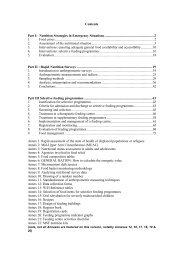UNHCR Handbook for Emergencies - UNHCR eCentre
UNHCR Handbook for Emergencies - UNHCR eCentre
UNHCR Handbook for Emergencies - UNHCR eCentre
You also want an ePaper? Increase the reach of your titles
YUMPU automatically turns print PDFs into web optimized ePapers that Google loves.
❏ Do not engage in unruly group discussions;<br />
❏ When discussing grievances, meet with a<br />
small number of representatives of the<br />
crowd, never with the mass meeting;<br />
❏ Provide sanitary facilities, water, shade and<br />
shelter;<br />
❏ For crowd control, use monitors from<br />
among the people themselves;<br />
❏ If confronted by a crowd when in a vehicle,<br />
do not get out. Check that the doors are<br />
locked and drive away carefully;<br />
❏ Maintain poise and dignity if confronted by<br />
a hostile crowd, do not show anger.<br />
Mine Awareness<br />
32. In countries with high risk of mines, all<br />
offices should ensure there is appropriate<br />
training and reference materials (see references)<br />
– the in<strong>for</strong>mation contained here is not<br />
sufficient, but provides only broad guidance.<br />
33. It is extremely difficult to spot a mined<br />
area, so the first priority is to ensure you have<br />
up to date in<strong>for</strong>mation about possible mined<br />
areas from local residents and de-mining<br />
organizations. Travel with a map marked with<br />
this in<strong>for</strong>mation and update it by checking<br />
with local residents.<br />
34. Be aware of the following:<br />
❏ Signs: learn which signs indicate known<br />
mined areas (whether local signs, UN or<br />
other signs);<br />
❏ No-go areas: avoid areas which are avoided<br />
by the local population;<br />
❏ Visible mines or indicators: some mines are<br />
visible. There may also be evidence of mine<br />
packaging;<br />
❏ Disruption in the local environment: <strong>for</strong> example<br />
disturbed soil if recently laid, and depressions<br />
in the ground in an old mine field;<br />
❏ Trip wires;<br />
❏ Mine damage (e.g. dead animals) which<br />
could indicate the presence of other mines.<br />
35. When driving, the following precautions<br />
should be taken:<br />
❏ Wherever possible stay on hard surfaced<br />
roads.<br />
❏ Always follow in the fresh tracks of another<br />
vehicle, at least 50 m behind the vehicle in<br />
front.<br />
❏ Flak jackets can be used as a seat cushion<br />
and as a foot protection.<br />
❏ Wear the seat-belts, and keep windows<br />
rolled down and doors unlocked.<br />
36. If you encounter a mine:<br />
❏ Keep away, do not touch it;<br />
❏ Do not try to detonate it by throwing<br />
stones at it;<br />
❏ Stop the vehicle immediately;<br />
❏ Stay in the vehicle, even if it is damaged<br />
and call <strong>for</strong> assistance.<br />
37. If you have to leave the vehicle:<br />
❏ Notify your location by radio;<br />
❏ Do not move the steering wheel;<br />
❏ Put on any protective gear available;<br />
❏ Climb over the seats and leave the vehicle<br />
by the rear, walk back along the vehicle<br />
tracks. Never walk around the vehicle;<br />
❏ Leave at least a 20 m gap between people;<br />
❏ Close the road to other traffic.<br />
38. When travelling on foot:<br />
❏ Never walk through overgrown areas: stick<br />
to well used paths.<br />
39. If there is a mine incident:<br />
❏ Do not immediately run to the casualty.<br />
Stop and assess the situation first. There<br />
may be other antipersonnel mines in the<br />
vicinity, and administering first aid to one<br />
victim could result in another victim;<br />
❏ Only one person should go to the casualty,<br />
walking in his exact footprints, to apply<br />
first aid;<br />
❏ Do not attempt to move the casualty unless<br />
absolutely necessary, call <strong>for</strong> mine-clearing<br />
and medical assistance.<br />
40. Within the UN system, mine clearance<br />
and related issues are primarily the responsibility<br />
of DPKO. Chapter 19 on voluntary<br />
repatriation contains some in<strong>for</strong>mation about<br />
programme aspects of mines.<br />
Protection Equipment:<br />
41. Typical equipment that has been used by<br />
<strong>UNHCR</strong> includes:<br />
i. Bullet proof vests <strong>for</strong> protection against<br />
most bullets;<br />
ii. Flak jackets <strong>for</strong> protection against shrapnel;<br />
iii. Helmets <strong>for</strong> protection against shrapnel;<br />
Staff Safety<br />
23<br />
331



